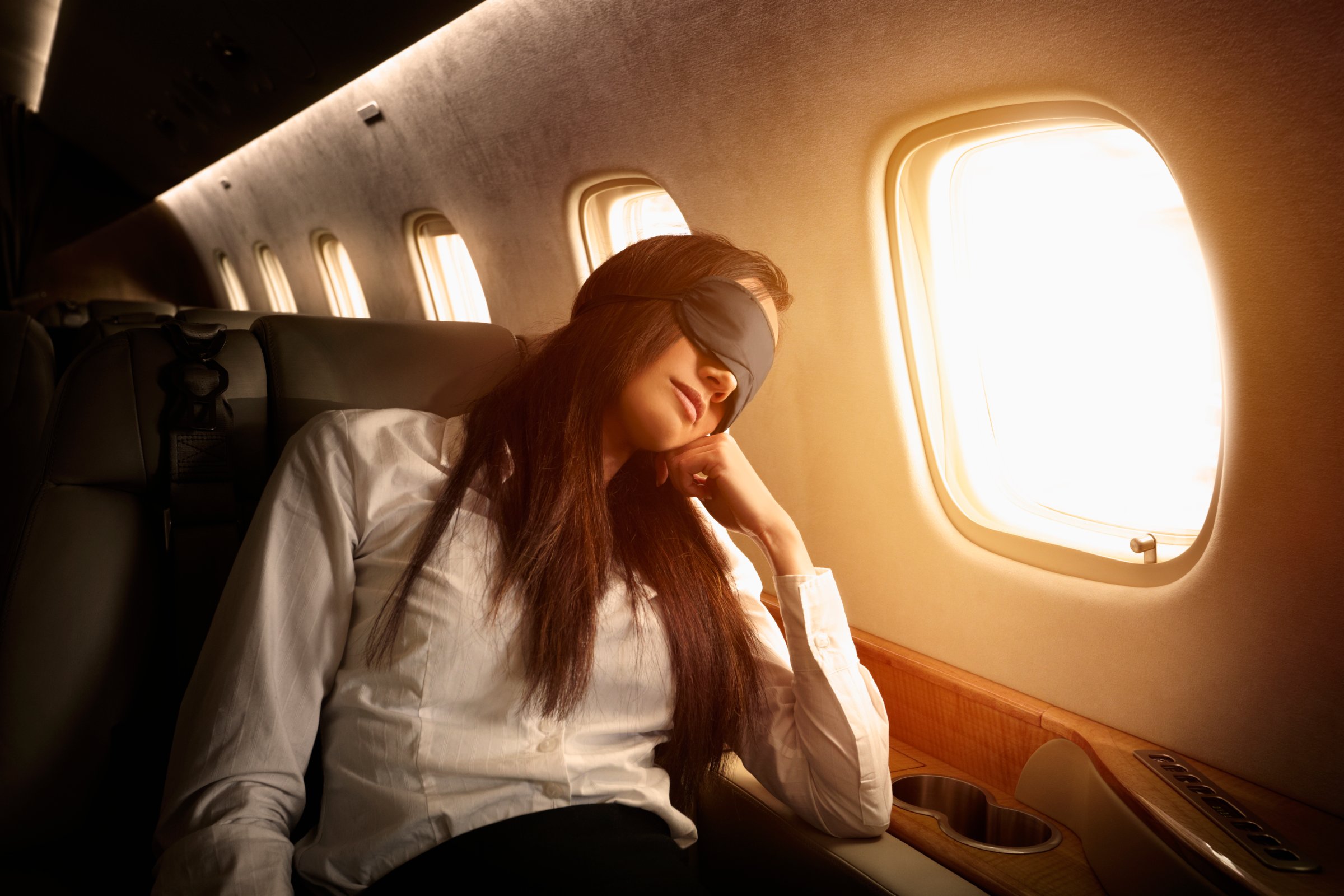
Whether you’re jetting from coast to coast or around the world, jet lag is a downright drag. A little background on the traveler’s worst enemy: “Jet lag occurs when we experience a desynchronization between our internal body clock and the external time clock of our destination,” explained Natalie Dautovich, Ph.D., an Environmental Fellow at the National Sleep Foundation. “Symptoms of this desynchronization include fatigue, difficulty sleeping, difficulty concentrating, indigestion, and a negative mood.”
None of those symptoms make for a very fun vacation. One of the best ways to avoid that “desynchronization” is to sleep on the plane on your way to the destination. There’s just one problem: “Airplanes are a terrible place to sleep,” said Dr. Carl Bazil, a sleep specialist and professor of neurology at Columbia University.
So how do you actually get a good night’s sleep on a plane? “Travel first class,” said Dr. Bazil, with a laugh. If that’s not an option, the sleep experts had a few suggestions for how to get something resembling a good night’s sleep on an economy budget.
Book Your Plane Ticket Carefully
“Select a flight that allows early evening arrival,” suggests Dautovich, which could mean skipping sleep entirely and making it easier to stay up until 10 p.m. local time, which is the suggested bedtime when visiting a destination that adheres to a different time zone.
Read more: The 50 Best New Travel Apps for 2017
Set Your Watch
Having a visual cue can help your body adjust to the time more quickly. That’s why Dautovich recommends adjusting your watch or the clock on your phone to the time at your destination as soon as you get on the plane. That way, your mind will begin to adjust to the new time zone.
Take Melatonin
“Melatonin is a hormone that your body naturally produces around bedtime,” said Dr. Bazil. “Taking melatonin from a drug store can help your body adjust to the new time zone when you take it at what you want to be your new bedtime. If you take the melatonin your body says ‘Oops, I messed up, now it’s bedtime,’ and you fall asleep.” Dr. Bazil said the body only needs one milligram of the drug, even though it’s typically sold in larger dosage. “Larger doses will help induce drowsiness, but you onlyneed one milligram,” he explained.
Read more: 15 Travel-friendly Headphones That Will Make Any Trip More Enjoyable
Eat Before You Get on the Plane
“Eat before you get on the plane,” said Dr. Bazil. “It’s part of the circadian rhythm where you’re trying to tell your body, ‘OK, this is dinnertime.’ Plus, you don’t have to wait on the plane until they give you the bad meal and you can just go to sleep.”
Bring a Sleep Mask
“Light inhibits melatonin,” said Dr. Bazil. “It encourages wakefulness.” Bazil suggests avoiding bright lights, including phones and computers to avoid wakefulness. That means no movies, e-readers, or lights once the plane takes off, and packing an eye mask to avoid as much light as possible on late-night flights.
Use a Neck Pillow
“Neck pillows help a lot if you’re in coach, because people’s necks just snap when they can’t really recline,” said Bazil. “You have to do whatever you can to make yourself more comfortable.”
Bring Something From Home
Dautovich recommends that in order to actually sleep on the plane, travelers should try to mimic the ideal bedroom environment, which is dark, quiet, cool, and comfortable. “Bring an eye mask, ear plugs, wear comfortable clothing, and if possible, bring an item of bedding from home,” she said.
Read more: How to Train Yourself to Need Less Sleep
Skip the Drink
While a nightcap may sound like an easy way to slip into slumber, according to Dautovich, alcohol before bedtime can actually act as a stimulant. That’s the last thing you want on a long-haul flight.
This article originally appeared on TravelandLeisure.com
More Must-Reads From TIME
- The 100 Most Influential People of 2024
- Coco Gauff Is Playing for Herself Now
- Scenes From Pro-Palestinian Encampments Across U.S. Universities
- 6 Compliments That Land Every Time
- If You're Dating Right Now , You're Brave: Column
- The AI That Could Heal a Divided Internet
- Fallout Is a Brilliant Model for the Future of Video Game Adaptations
- Want Weekly Recs on What to Watch, Read, and More? Sign Up for Worth Your Time
Contact us at letters@time.com